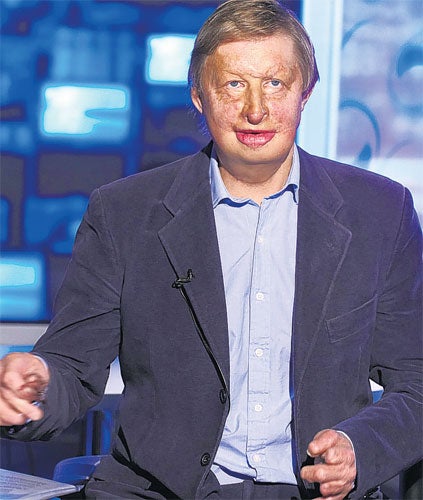Newsflash: it's time to face up to disfigurement
Five's lunchtime bulletin is to radically test prejudices about the looks of newsreaders, reports Ian Burrell

Channel Five, the broadcaster which famously pays the glamorous Natasha Kaplinsky £1m a year to read the news, will today put before the autocue a man who, to use his own description, has a face made up of "a patchwork quilt of scars".
Fronting the Five News lunchtime bulletin today and throughout this week will be James Partridge, whose face was so horrifically burned in a car accident that he needed five years of surgery to replace it with skin grafted from his back and other parts of his body. Partridge, 57, has had intensive training to be a news anchor – one of the most prestigious roles in broadcasting and one of the most controversial given the apparent obsession of television executives with youthful good looks.
The question, which Partridge himself quickly raises, is whether it's all just a big stunt? "Well, of course it is, in a way, but we don't make any excuses for that," he says. "We see this is as a way of challenging people's perceptions." Partridge has had 39 years since his teenage road crash to deal with the embarrassment of strangers being repulsed by his looks, but still acknowledges that his appearance might cause some viewers to reach for the remote. "The question as to whether people will switch off is interesting," he says. "If it's the case that disfigurement is not seen as 'acceptable' in the role of news reading then we have a long way to go in terms of changing attitudes in Britain."
A former farmer and A-level teacher, Partridge is now chief executive of the charity Changing Places, which represents half a million people in Britain with disfigurements to the face, hands or body caused by birth defects, accidents, disease, war and street violence. He managed to persuade Five News executives Chris Shaw and David Kermode that an experiment in newscasting could be especially powerful in confronting prejudice. "Newsreading was interesting because it's full frontal to the camera, there's no holding back," he says. "Too often, disfigurement is shrouded in negativity and tragedy, presented as something to be hidden away or surgically removed."
He admits to nerves, saying: "I don't want to appear on screen and make a fool of myself. But they have put me through some tough training." The five-minute, 12.30pm news – unlike Kaplinsky's live 5pm bulletin – is pre-recorded just before broadcast, minimising the danger of Partridge making howlers. He has a little broadcasting experience, having once hosted Down On The Farm With James Partridge on Radio Guernsey during his time as a dairy farmer.
Britain's highly paid newscasters might be nervous at the prospect of a newcomer making the job look easy, but Partridge says it is "much harder than I was anticipating". "It's not the reading per se, it's getting the right tone, the right pace, the right emphasis," he says. "There's some considerable skill to it. I will be wearing L plates and I hope it won't show too much."
Kermode, the editor of Five News, produced by BSkyB, says he is confident the audience will not switch off, particularly after commissioning a YouGov survey which found that 84 per cent of viewers said they had no problem with someone with a facial disfigurement presenting a television programme. "We are of the view that it is important to address disability as it relates to the media and to have some balanced representation on and off screen," adds Kermode.
Partridge said it was important that Five committed to the project for a week, rather than just a single bulletin. Before he goes on air, he will be dusted with the air-brush to reduce shine ("we did some screen tests and the lights were unkind") but he will otherwise avoid make-up, unlike his colleagues in the newsreading business. And he's happy to do just the lunchtime bulletin. "It's extraordinary how quickly it goes but it's very concentrated. Doing a half-hour news bulletin, that's a serious challenge."
In the years immediately after his disfigurement, Partridge greatly regretted the loss of the "social anonymity" that comes with being able to walk into a crowded room unnoticed. "Gradually I got used to the idea that being noticeable was something I could handle," he says. "Being in the public eye is something I have decided I need to do in order to make things easier for many other people. That's why I'm doing this."
Newsreaders can find themselves cast aside not just through lack of beauty but for having grown older (witness the treatment of Moira Stuart). That's one thing Partridge seems less worried about. "One of the bonuses of having a face like mine, mostly composed of skin from other parts of my body, is that the ageing process is held back," he comments cheerily. "Because it's tight you don't get very much wrinkle."
Subscribe to Independent Premium to bookmark this article
Want to bookmark your favourite articles and stories to read or reference later? Start your Independent Premium subscription today.

Join our commenting forum
Join thought-provoking conversations, follow other Independent readers and see their replies